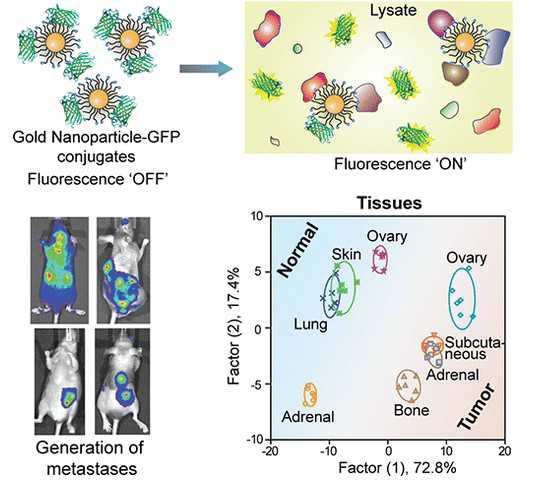ACS Nano:纳米-GFP 感受器可检测不同转移癌
2012-09-19 T.Shen 生物谷
在对抗癌症过程中,了解癌症具体的身份特征对于癌症诊断和有效的疗法至关重要,尤其是在转移癌中,分析具体癌症的特性对于开发新型疗法显得尤为重要。如今来自马萨诸塞大学的研究者开发出了一种快速超灵敏的技术在显微水平来检测活组织中不同类型的转移癌的发生。相关研究成果刊登在了近日的国际杂志ACS Nano上。 马萨诸塞大学的研究者开发出了一种快速超灵敏的技术在显微水平来检测活组织中不同类型的转移癌的发生
在对抗癌症过程中,了解癌症具体的身份特征对于癌症诊断和有效的疗法至关重要,尤其是在转移癌中,分析具体癌症的特性对于开发新型疗法显得尤为重要。如今来自马萨诸塞大学的研究者开发出了一种快速超灵敏的技术在显微水平来检测活组织中不同类型的转移癌的发生。相关研究成果刊登在了近日的国际杂志ACS Nano上。

马萨诸塞大学的研究者开发出了一种快速超灵敏的技术在显微水平来检测活组织中不同类型的转移癌的发生。
目前标准的检测方法是使用生物受体方法来检测癌细胞,但是研究者Rotello表示,运用这种新型技术,我们可以更加精确地检测和识别动物活组织中的转移肿瘤细胞,而且该方法快速有效。研究者使用一系列的黄金纳米传感器,加上绿色荧光蛋白(GFP)结合的技术,来激活传感器,并且在数分钟内对特定的癌细胞蛋白质产生反应,从而对不同类型的癌症分类。
如果这种检测系统“嗅出”A型癌症,就会在激活的传感器中产生一种特定记忆模式,如果“嗅出”B型癌症,就会产生另一种不同的记忆模式。研究者使用健康的组织和小鼠的肿瘤组织,并且使用纳米-GFP 感受器来识别健康组织和肿瘤组织。研究者Rotello表示,这套系统可以快速精确检测出癌症组织和健康组织的差别,从而来判断组织是否潜在癌变。
为了提高检测系统的敏感性,研究者指出,传感器可以分别对低的和高的癌症转移灶进行辨别,而且在特定的肿瘤细胞中进行辨别,如肝癌细胞、肺癌细胞等。
总之,这套基于阵列的传感器检测系统表现出了强大的快速检测肿瘤的能力,下一步研究者希望在人类组织中进行相应的癌变检测。
编译自:Chemists Develop Nose-Like Array to 'Smell' Cancer

doi:10.1021/nn302917e
PMC:
PMID:
Array-Based Sensing of Metastatic Cells and Tissues Using Nanoparticle–Fluorescent Protein Conjugates
Subinoy Rana †, Arvind K. Singla ‡, Avinash Bajaj †, S. Gokhan Elci †, Oscar R. Miranda †, Rubul Mout †, Bo Yan †, Frank R. Jirik ‡, and Vincent M. Rotello †*
Rapid and sensitive methods of discriminating between healthy tissue and metastases are critical for predicting disease course and designing therapeutic strategies. We report here the use of an array of gold nanoparticle–green fluorescent protein elements to rapidly detect metastatic cancer cells (in minutes), as well as to discriminate between organ-specific metastases and their corresponding normal tissues through their overall intracellular proteome signatures. Metastases established in a new preclinical non-small-cell lung cancer metastasis model in athymic mice were used to provide a challenging and realistic testbed for clinical cancer diagnosis. Full differentiation between the analyte cell/tissue was achieved with as little as 200 ng of intracellular protein (1000 cells) for each nanoparticle, indicating high sensitivity of this sensor array. Notably, the sensor created a distinct fingerprint pattern for the normal and metastatic tumor tissues. Moreover, this array-based approach is unbiased, precluding the requirement of a priori knowledge of the disease biomarkers. Taken together, these studies demonstrate the utility of this sensor for creating fingerprints of cells and tissues in different states and present a generalizable platform for rapid screening amenable to microbiopsy samples.
本网站所有内容来源注明为“梅斯医学”或“MedSci原创”的文字、图片和音视频资料,版权均属于梅斯医学所有。非经授权,任何媒体、网站或个人不得转载,授权转载时须注明来源为“梅斯医学”。其它来源的文章系转载文章,或“梅斯号”自媒体发布的文章,仅系出于传递更多信息之目的,本站仅负责审核内容合规,其内容不代表本站立场,本站不负责内容的准确性和版权。如果存在侵权、或不希望被转载的媒体或个人可与我们联系,我们将立即进行删除处理。
在此留言








#转移癌#
73
#ACS#
65